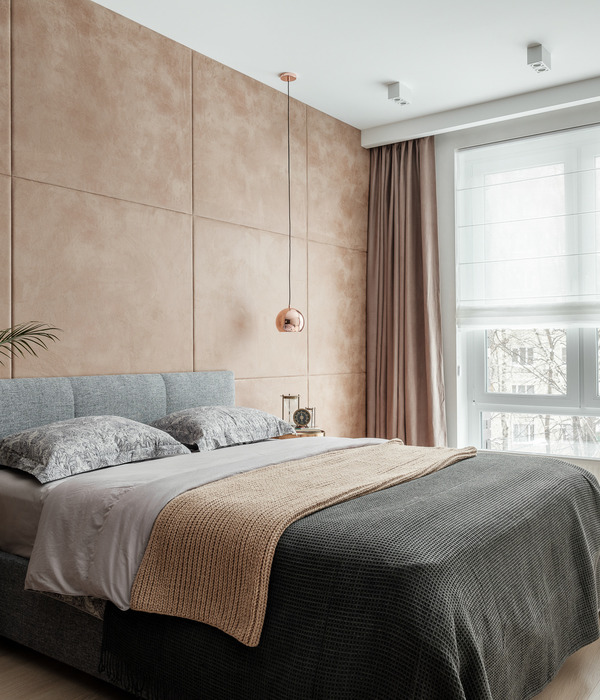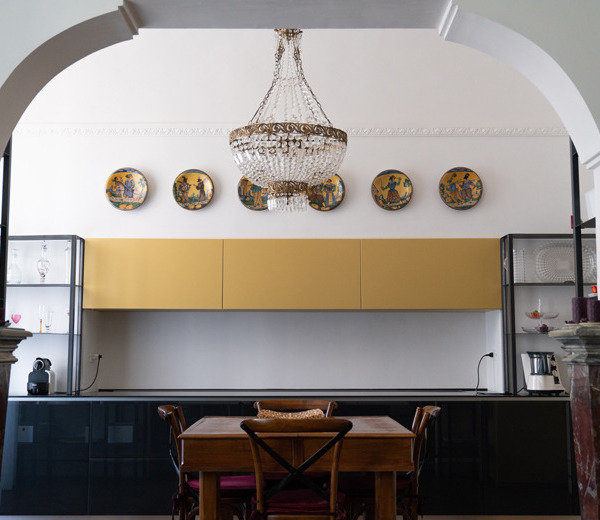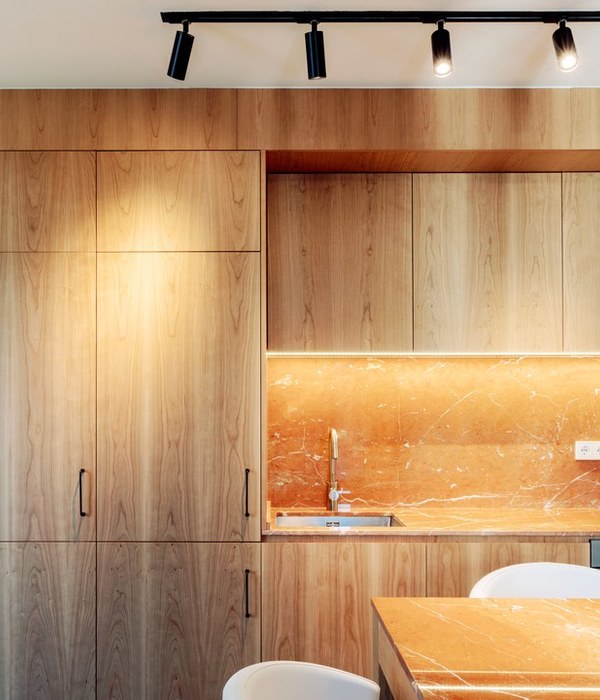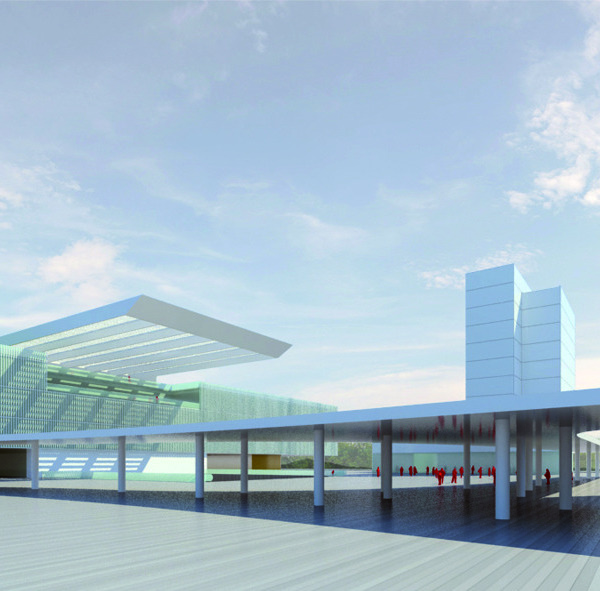本项目将一个曾经的老旧发电厂改造为了一个创新性的办公建筑,从而为多家公司提供工作空间。本项目的旧址是一座重工业综合体,完全不适合办公,而经过改造,这座十分粗野且原始的建筑摇身一变,成为了一个宽敞舒适的办公大楼,为人们提供了一个通风的、清新的、富有活力的工作环境。
Former power plant transformed into the multi-tenant Innovation Powerhouse. A transformation from a pure, brute, raw and heavy industrial complex – in size and volume completely unsuitable for office use – into a comfortable, breathing, spacious, fresh and young work environment.
▼办公大楼外观,exterior view of the Innovation Powerhouse
本项目作为一个创新型产业的摇篮,由建筑事务所Atelier van Berlo、Eugelink Architectuur和De Bever Architecten共同完成。具体来说,这座由发电厂改造而成的办公大楼是一个创意中心,也是一个超现代的多租户建筑,在这里,不同的公司可以相互交流,彼此激励,甚至可以在交往中给予对方灵感,从而创造出更多的创新型产品。本项目的旧址,即前发电厂,坐落于荷兰埃因霍温市(Eindhoven)的Strijp-T小镇上,曾是这里的一座地标性建筑。整个发电厂的建设工程从1953年开始,一直到1972年才结束,共经历了四期工程,曾经通过燃烧煤、天然气和石油来为飞利浦工厂提供电力。
热衷于设计的建筑事务所van Berlo最先发起了这个发电厂的改造项目,在与此同时,他们也在物色一个合适的新总部大楼。他们构想了一个独特的工作空间——这个工作空间不仅仅是他们的新办公总部,更是像一个开放式的生态系统一般,在其中工作的人们能够彼此合作,相互激励。因此,这个生态系统就应该具备为不同富有创新精神的公司、大学、合作伙伴、客户、甚至是游客们提供共享工作空间的能力,从而创造出可以改变人类未来的成果。
Designed by Atelier van Berlo, Eugelink Architectuur, and De Bever Architecten, the Innovation Powerhouse is an ecosystem for the innovative industries. A centre of creativity; a hyper-modern, multi-tenant building where different companies meet, inspire and stimulate innovation. Situated on Strijp-T, the out of use power plant is an iconic building, a landmark of Eindhoven. Built in four stages, from 1953 till 1972, the power plant used to provide Philips factories with power through coal, gas and later oil.
Design-driven innovation agency van Berlo initiated the transformation, while in search for their own new headquarters. They envisioned a unique working space, an open ecosystem focused on collaboration, something more than just their own new headquarters. It would be an ecosystem for different innovative companies, universities, partners, clients, and visitors to work together and create the innovations that shape the future.
▼办公大楼外观,烟囱与后方通透的建筑交相辉映,exterior view of the Innovation Powerhouse, chimney and the transparent building complement each other
设计的两个主要出发点是保持发电厂最初的建筑特点,同时将开放式的创新视界融入其中。 欣慰的是,这种新老元素之间的联系作为基础概念,贯穿了设计的始终。建筑师们希望在这座建筑中,不同的公司能够不断地发生互动,从而在不经意间激发灵感,将这个办公大楼打造为一个活力中心。
The two main points of departure for the design were to maintain the building’s innate architectural qualities and to incorporate this vision of open innovation. Throughout the design this idea of connectives was essential. The architects wanted the companies to constantly meet, to create an almost effortless inspiration of one another, which was translated into a vibrant centre.
▼办公大楼外观,保持原建筑的特点,同时增加空间的现代性,exterior view of the Innovation Powerhouse, maintaining the building’s innate architectural qualities and adding the modern sense to it
随后,建筑后方一个加建的玻璃体量完成并突出了整体体量的对称式外观。这个玻璃体量遵循了现有建筑的轮廓和韵律,通过极简主义风格的细节设计和一系列现代化的材料,清晰明了地向人们展示了该建筑正在经历的新阶段。
The symmetrical look is finished by a glass extension at the back of the building. It follows the lines and rhythm of the building, but through a minimalistic detailing and modern materials, it indicated clearly a new phase for this impressive building.
▼办公大楼外观局部,建筑后方加建的玻璃通透体量完成并突出了整体体量的对称式外观,partial exterior view of the Innovation Powerhouse, the symmetrical look is finished by a glass extension at the back of the building
为了建造这个活力中心,建筑师在建筑的中心位置创造了一个贯通的直线线性空间,这个线性空间横跨了原建筑的核心空间——一个5米宽的高层空间,这里曾是烟囱的驻扎地,如今烟囱的放煤溜槽还悬挂在距离地面28米的位置上。沿着这个中央核心空间,建筑师将一部分原有屋顶全部替换成了与建筑同长的天窗,从而不仅将自然光线引入原先有些昏暗的中心空间内,更展示出原有重型混凝土结构的大小。此外,透过这个天窗,人们还可以看到办公大楼的外立面,使所有人都能体会到建筑正中心位置的惊人高度。
To create this vibrant centre, the architect created a clear-cut in the building, a straight line through the heart spanning among others the original central backbone, a 5-meter wide high-rise where the cole chutes still hang at 28-meter hight. Next to this central backbone, the roof is opened up by a skylight spanning the full length, bringing light into the otherwise dark centre of the building and revealing the magnitude of the old heavy concrete structure. In addition, this skylight gives a peek at the facade, allowing all who view it to experience the sheer height of the midpoint.
▼建筑中心贯通的直线线性空间,屋顶边沿设置与建筑同长的天窗,the the straight linear space clear-cutting in the building, the roof next to it is opened up by a skylight spanning the full length
▼建筑中心贯通的直线线性空间,可以看到原有的混凝土建筑结构,the straight linear space clear-cutting in the building, the original concrete structures can be seen
▼建筑中心贯通的直线线性空间中的楼梯空间,stairs space of the straight linear space clear-cutting in the building
然而,由于发电所需要的原料发生了改变,这个5米宽的核心高层空间从一开始,就没有如人们最初所设想的那样发挥其作用。而也正是因为不再需要放煤溜槽,该空间也从未彻底完工。因此,受到最初的设计图纸的启发,建筑师在中央的高层空间内增加了一个钢制的垂直花园,自此,这座见证了几十年风风雨雨的建筑终于如最初的设想一样,拥有了一个对称的外观。这个垂直花园中设有一系列会议室和一座玻璃电梯,紧急出口则按照原始建筑的流线和节奏布置。开放、通透的、种有绿植的外观造型也暗示着新的可持续绿色能源的产生。
Due to a change in power fuelling, the original design was never finished. Since there was no longer a need for cole chutes, the 5-meter wide high-rise was never finished. Inspired by the original drawings, the architects added a steel vertical garden to the central high-rise, giving the building its originally intended symmetrical look. This vertical garden with meeting rooms, a glass elevator and emergency exit follows the lines and rhythm of the original architecture. The open, transparent and green appearance hints at a new sustainable green energy production.
▼建筑内部的钢制垂直花园,视野开放,the interior vertical steel garden with an open sight
▼钢制垂直花园旁边的会议空间,the meeting space beside the interior vertical steel garden
▼钢制垂直花园旁边的空间局部,透过玻璃墙体可以看到室外环境,the space beside the vertical steel garden, outside environment can be seen through the glass wall
本项目中还有其他的一系列干预设计,如办公室和主入口处的采光窗户在体量上都很小,从而避免了影响建筑原有的工业性。此外,在更新改造的过程中,建筑师们也十分关注项目的可持续性。通过使用HR+型玻璃、太阳能板、全新的具有保温隔热功能的墙体和屋顶,赋予了该建筑一个A+能源等级的标签。
The other interventions, such as the small windows for light in the offices and the main entrance, are kept small, to ensure that the monumental industrial character of the building stays visible. Within the renovation, there was also great attention for sustainability. Due to HR + glass, solar panels, newly isolated walls and roofs, the building now has an A+ energy label.
▼办公大楼外观夜景,night view of the Innovation Powerhouse
▼一层平面图,1F plan
▼二层平面图,2F plan
▼三层平面图,3F plan
▼剖面图,section
Address: Zwaanstraat 31, 5616 RD Eindhoven Architects: Atelier van Berlo in collaboration with Eugelink Architectuur & De Bever Architecten Interior: Atelier van Berlo Type: Transformation Function: Multi-tenant office building Size : 11,000 m2 Period: 2015 – 2018 Original construction: 1953 – 19872 Developer: Geva Vastgoed Photo’s: Tycho Merijn
{{item.text_origin}}












